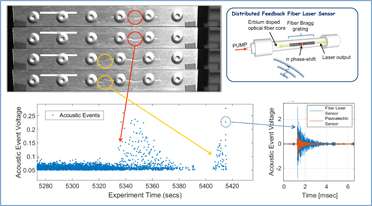New fiber laser sensor technology for structural health monitoring systems

Researchers at the U.S. Naval Research Laboratory (NRL), Optical Sciences Division, in collaboration with the laboratory's Material Science Division, for the first time have demonstrated successful detection of acoustic emission from cracks in riveted lap joints using a distributed feedback fiber laser-acoustic emission sensor.
"An automated, in-situ structural health monitoring (SHM) system, capable of monitoring key structural parameters such as temperature, strain, impacts and cracks, and capable of reliably detecting damage well before reaching a critical level is needed to increase safety and readiness while lowering operational cost of Navy platforms" said Dr. Geoffrey Cranch, research physicist, Optical Sciences Division. "At present, none of the services are using in-situ technologies to manage the structural health of their assets."
To accomplish this goal, sensors that can detect acoustic emission signatures associated with crack initiation and growth, in near real-time, are required. Such a sensor must be smaller and lighter than existing electrical equivalents, possess comparable or improved sensitivity, be easily multiplexed, and achieve all of these components with a small system footprint and high reliability.
Funded partially by the Office of Naval Research (ONR) Navy Materials Division, the NRL-developed laser sensor is integrated into a shallow groove formed in the lap joint and consists of a single fiber, similar in width to a human hair. In testing the application, optical and material science researchers installed distributed feedback fiber laser acoustic emission sensors into a series of riveted aluminum lap joints and measured acoustic emission over a bandwidth of 0.5 megahertz (MHz) generated during a two-hour accelerated fatigue test. Measurements were also taken with an equivalent electrical sensor.
The embedded sensors were shown to resolve low-level acoustic events generated by periodic 'fretting' from the riveted joint in addition to acoustic emissions from crack formation. Time-lapse imagery of the lap joint enabled correlation of the observed fracture with the measured signals.
In addition to crack detection, the fiber laser sensor also proved capable of measuring compromising impacts, and the potential to integrate with existing fiber optic strain and temperature sensing systems. Combined, this provides a multi-parameter sensing capability for meeting the full operational safety requirements for an SHM system as well as a significantly lower total ownership costs.
"Our research team has demonstrated the ability of this fiber laser technology to detect acoustic emission at ultrasonic frequencies from cracks generated in a simulated fatigue environment," Cranch says. "The novel part of this work is the fiber laser technology and how it is being applied."
Acoustic signals from cracks can also be measured using piezoelectric sensors, and this technology has driven the existing work on failure prediction. However, the piezoelectric technology is generally not practical for many applications due to its large size and limited multiplexing capability.
Cranch adds that the technology does have possible applications beyond the military. "Our focus is on Navy platforms, such as aircraft, ships and submarines, but the technology could also be used on civilian aircraft," he said. "Applications to bridges and buildings are also possible if there are critical parts prone to fatigue and failure that would benefit from continuous monitoring."
Currently there is no other intrinsic optical fiber sensor capable of matching the performance obtained in the laboratory from the fiber laser acoustic emission sensor. The fiber laser sensor has demonstrated acoustic sensitivity comparable to, or greater than that achieved by existing electrical sensors. This system has now been expanded to multiplex many fiber lasers sensors onto a single fiber. Efforts are currently underway to interpret the acoustic emission data to calculate useful metrics such as probability of failure. Future enhancements include implementing phased array beam forming techniques to enable crack location.
Provided by U.S. Naval Research Laboratory



















